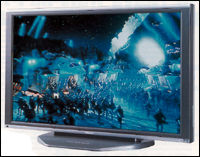| Columns Retired Columns & Blogs |
PDP-501MX 50" Plasma Monitor (SGHT Review)
The advance of plasma-display technology speeds on, and the Pioneer PDP-501MX is at the front of the line. This is the first plasma monitor on sale in the United States that is capable of displaying high-definition images, making it the world's most advanced, commercially available product of this type.Squeezing almost 1 million pixels into even a 50" display (measured diagonally) is quite an accomplishment. As soon as I pulled the unit out of the box and set it in its unobtrusive tabletop stand, I connected it to Panasonic's high-definition tuner box and fed the monitor an over-the-air HDTV signal. Without so much as a hiccup, the set accepted the 1920x1080i signal and displayed a bright, clear, sharp picture that made me smile. All this from a big-screen set less than 4" thick!
 However, a more thorough examination of the first sample Pioneer sent me turned up a darker side. The monitor had some serious problems, and a Pioneer executive confirmed that my experience is not an isolated case. Even so, after some to-and-fro with me, Pioneer decided to send another sample. All of the problems were still there, but most were much less severe. In normal use, you could not generally see them.
However, a more thorough examination of the first sample Pioneer sent me turned up a darker side. The monitor had some serious problems, and a Pioneer executive confirmed that my experience is not an isolated case. Even so, after some to-and-fro with me, Pioneer decided to send another sample. All of the problems were still there, but most were much less severe. In normal use, you could not generally see them.
Even with these difficulties (detailed shortly), I don't want to detract from the significant technological accomplishment behind this set. Plasma displays are the future of television, and Pioneer has pushed the envelope. No one currently offers a plasma monitor as advanced as this one.
Nor does anyone charge as much: $25,000! Nevertheless, people are buying it (usually for about $22,000). Pioneer reports that the PDP-501MX is on sale in more than 100 stores nationwide; I even saw a newspaper ad for it recently from a mail-order house in New York.
I said this is a high-definition monitor, and it is—just barely. It offers a maximum resolution of 1280x768, for a total of 983,040 pixels. The television industry has informally settled on the notion that a set must display at least 1 million pixels to qualify as an HDTV. Obviously, the Pioneer is awfully close; the missing 16,960 pixels are little more than a rounding error.
The Consumer Electronics Manufacturers Association (CEMA) officially declared last year that the industry considers 720-line progressive broadcasts to be high-definition—a fully justified decision, in my opinion. And 720p—which this monitor is perfectly capable of displaying—comes in at 1280x720. So let's not quibble. This is an HDTV.
First glance
Some manufacturers have tried to make a decorative statement with their plasma cabinets. Not Pioneer; the PDP-501MX comes in an unobtrusive, neutral-looking, silver-and-gray cabinet that virtually disappears. And the monitor is quiet. A small fan hums—plasma monitors naturally run hot—but it's less obtrusive than some others I've tested, including the Fujitsu Plasmavision 42.
The Pioneer has no speakers, not even the squeaky little things that come with other plasma monitors and whose only real use is to show that the signal does in fact have a soundtrack. So you'll have to use this set with a tuner and audio system, as anyone spending $25k probably would anyway.
The PDP-501MX is well equipped with inputs for both analog and digital signals: composite, component, or S-video for NTSC, and component or RGB for HDTV, among others. And alone among the makers of plasma sets I've seen thus far, Pioneer places the On/Off button and other controls where you can actually use them. Other plasma monitors, including the Fujitsu and Runco, place the controls on the bottom, facing down toward the table; anyone using them regularly will end up wearing a neck brace sooner or later. The Pioneer's controls are conveniently located on the right side of the cabinet.
The remote is not backlit, but it does provide all the essential controls. And the set offers the same resizing options found in all 16:9 monitors these days, plus a couple more, allowing users to stretch or squeeze signals that arrive in another aspect ratio. They work well enough in the Pioneer.
- Log in or register to post comments




































